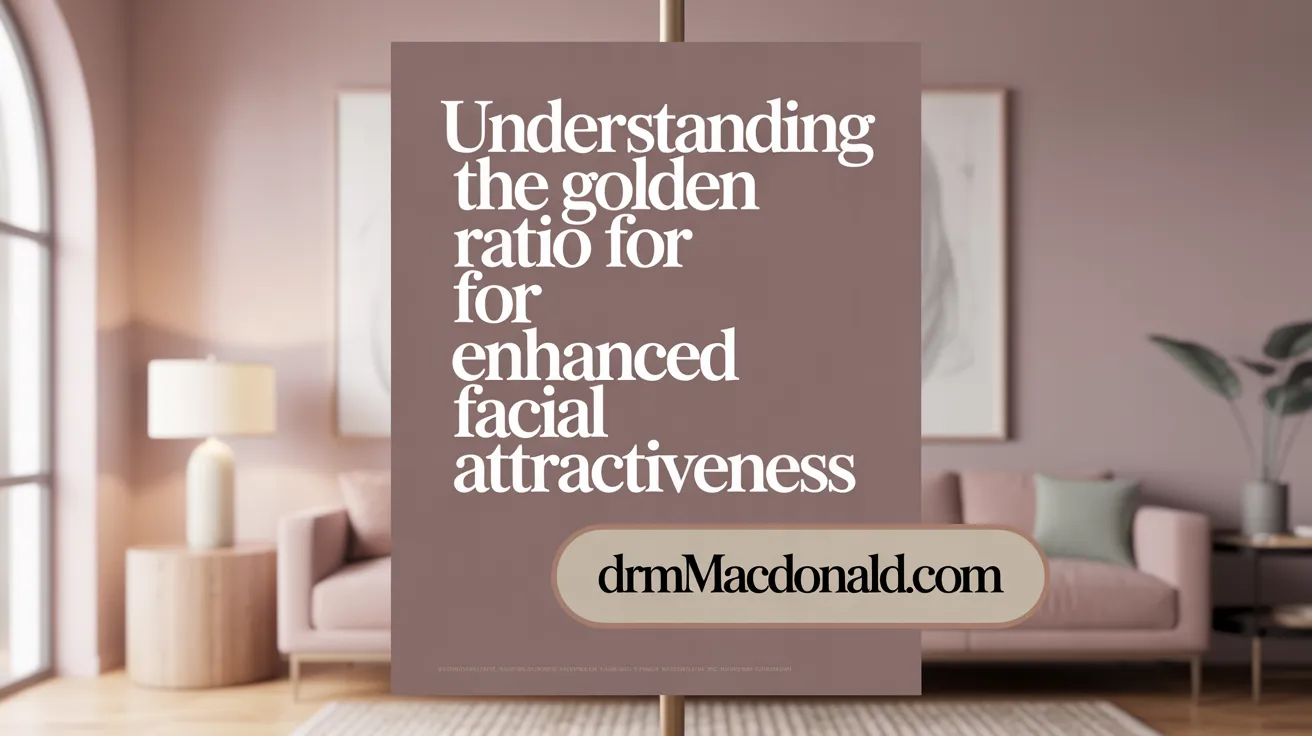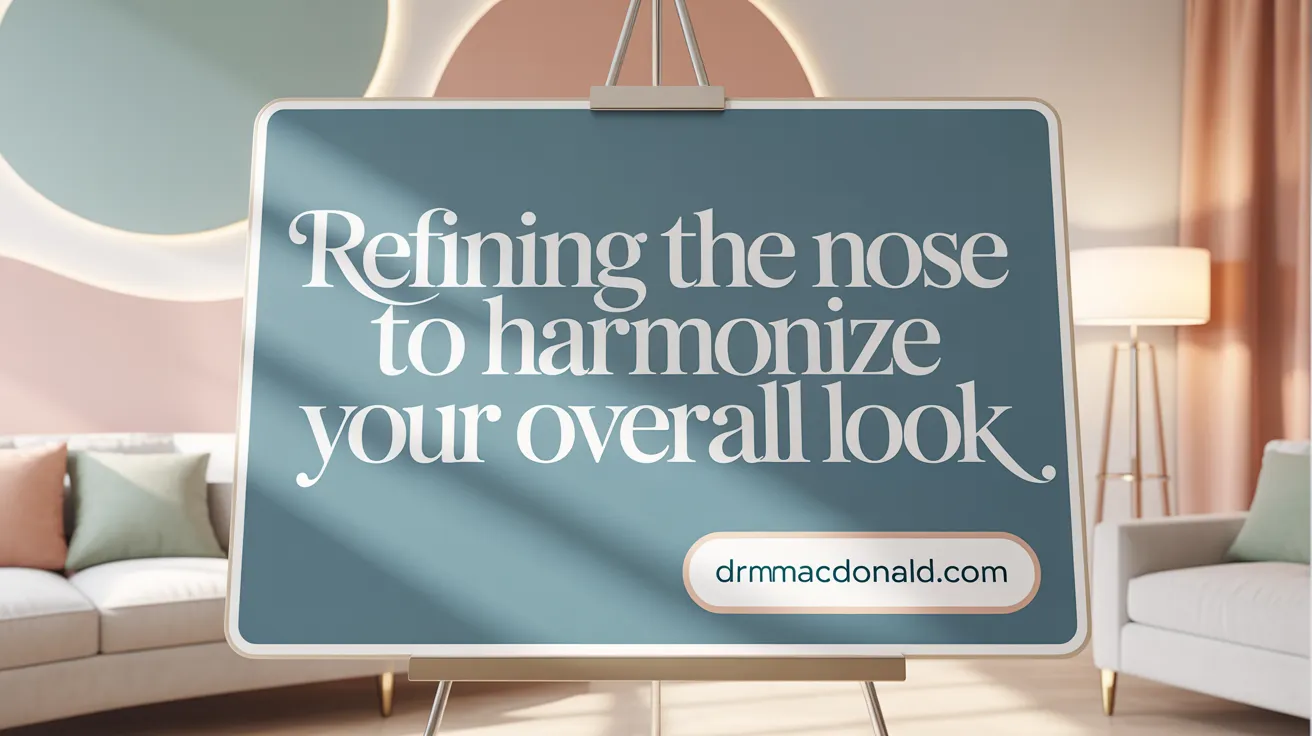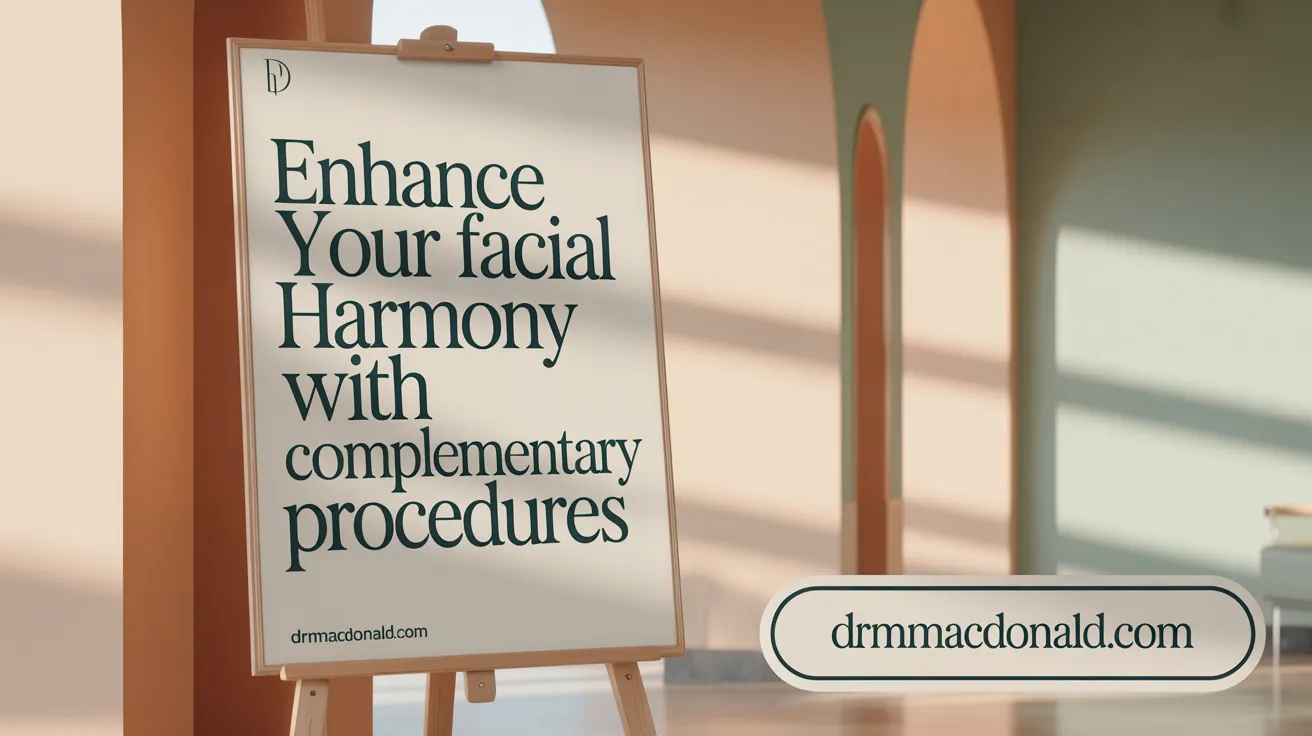Understanding the Role of Facial Harmony in Rhinoplasty
Definition of Facial Harmony
Facial harmony refers to how well the different features of the face work together to create a balanced, aesthetically pleasing appearance. This balance is often guided by principles like the Golden Ratio (~1:1.618), which evaluates the proportions of facial features such as the forehead, eyes, nose, lips, chin, and jawline. The face is typically divided into three equal horizontal sections—forehead to eyebrows, eyebrows to bottom of the nose, and bottom of the nose to chin—to help assess facial proportion and symmetry.
Importance of the Nose in Facial Aesthetics
The nose occupies a central position on the face, making it a focal point that significantly impacts overall facial harmony. Its size, shape, and alignment directly influence perceptions of attractiveness and balance. Specific ratios, such as the nasofrontal and nasolabial angles, guide surgeons in molding the nose to complement individual facial features while preserving ethnic and gender characteristics. Even minor nasal asymmetries or disproportionate features, like a wide nostril or a nasal hump, can disrupt this harmony.
How Rhinoplasty Influences Overall Facial Balance
Rhinoplasty plays a pivotal role in enhancing facial symmetry and balance by reshaping the nose to better fit the natural proportions of the face. Procedures may involve refining the nasal tip, narrowing nostrils, straightening a crooked nose, or reducing nasal length. These changes harmonize the nose with adjacent features such as the chin and cheeks, often supplemented by complementary treatments like chin augmentation. A well-executed rhinoplasty creates subtle yet impactful improvements that elevate the patient's overall facial attractiveness, maintaining naturalness and individuality.
The Science of Facial Proportions and Symmetry

What facial proportions are important in achieving aesthetic appeal?
Facial aesthetics heavily rely on proportions guided by the Golden Ratio in facial aesthetics, approximately 1:1.618, which serves as a foundational principle in evaluating facial harmony. One common approach divides the face into three equal horizontal sections: from the forehead to the eyebrows, from the eyebrows to the bottom of the nose, and from the nose base to the chin. These divisions help assess balance and ensure each facial section aligns proportionately with the others, creating a visually appealing harmony, as explained in Facial proportions and the Golden Ratio.
How does symmetry contribute to facial attractiveness?
Symmetry plays a critical role in perceived facial attractiveness. While minor asymmetries are natural and generally go unnoticed, significant differences between the two halves of the face can reduce overall facial harmony and appeal. Procedures like rhinoplasty often focus on correcting these disparities by aligning nasal structures and refining shape to enhance the balance of the face, discussed under How rhinoplasty improves facial symmetry.
What nasal ratios are important for harmony?
Specific nasal ratios influence facial harmony, including the nasofrontal angle, which ideally measures between 115°-130° for women and 120°-135° for men. The nasolabial angle ranges between 95°-110° for women and 90°-95° for men. Additionally, nasal width relative to eye spacing and midface width is carefully considered in aesthetic planning. Adjusting these ratios during rhinoplasty enhances the nose’s relationship with surrounding features, contributing to an overall symmetrical and balanced appearance, as detailed in Nasal ratios for harmony.
Nose Reshaping: Central to Facial Harmony

Why is the nose considered central to facial harmony?
The nose is uniquely positioned at the very midpoint of the face, making it the central and most prominent feature. Because of this central placement, the nose's position in facial balance has a profound impact on overall facial balance and harmony. Even subtle changes to the nose can shift the aesthetic equilibrium of the face, enhancing the cohesion among other features such as the eyes, lips, and chin.
How do nasal size, shape, and alignment impact facial balance?
Nasal proportions must be carefully tailored to complement the rest of the face. An overly large, crooked, or disproportionate nose can disrupt facial symmetry and attractiveness. Ideal nasal angles and widths—such as the nasofrontal angle and nasolabial angle—are assessed to maintain natural aesthetic appeal. For instance, the nose width and face width ratio, which aligns with classical facial proportion guidelines like the Golden Ratio in facial aesthetics, is generally about one-fifth of the face width.
What nasal features are commonly improved in rhinoplasty to enhance facial symmetry?
Rhinoplasty often addresses:
- Correcting nasal humps that disrupt a smooth nasal profile
- Narrowing wide nostrils that affect facial proportion
- Refining bulbous nasal tips that diminish definition
- Aligning crooked or deviated noses that interfere with central alignment
- Correcting deviated septa that impact both appearance and breathing
Refining these features not only improves facial symmetry but can also enhance nasal function.
What ethnic and gender considerations influence nasal aesthetics?
Ethnic background and gender significantly inform nasal aesthetics, as different populations have characteristic nasal shapes and proportions. For example, typical nasal angles and shapes differ between men and women, necessitating customized approaches. Surgeons prioritize preserving cultural identity and individual features while enhancing facial harmony, using advanced imaging techniques in rhinoplasty for detailed preoperative planning.
This nuanced understanding ensures customized treatment plans in facial plastic surgery so that rhinoplasty results are natural-looking and personalized, creating balanced and attractive facial harmony without compromising individuality.
Complementary Procedures to Enhance Overall Facial Balance

How do complementary procedures improve facial harmony with rhinoplasty?
Rhinoplasty can significantly enhance facial harmony by reshaping the nose, but combining it with other procedures can optimize the balance across the entire face. For instance, chin augmentation often complements rhinoplasty by refining the profile and ensuring the nose and chin have a well-proportioned relationship. This balancing act can address issues where a weak chin might make the nose appear disproportionately large.
In addition to chin work, cheek and lip enhancements can provide volume and contour that harmonize with the refined nasal structure. Procedures such as brow lifts, facelifts, and eyelid surgery further contribute by rejuvenating surrounding facial areas, creating an overall balanced and cohesive look.
Why is a personalized approach important for facial harmony in rhinoplasty?
Achieving natural and harmonious results requires a customized treatment plan tailored to each patient’s unique facial features, ethnic background, and aesthetic goals. A personalized approach avoids the application of generic ideals and instead enhances individual beauty, respecting cultural traits and anatomical differences.
Experienced surgeons carefully evaluate facial proportions, including the relationship between the nose and other features like the chin and cheeks, to recommend complementary treatments when appropriate. This ensures results that look natural, balanced, and maintain the patient’s individuality, expressing their best self rather than a standardized ideal.
Advanced Techniques and Personalized Planning
How do customized treatment plans improve rhinoplasty outcomes?
Customized treatment plans in facial plastic surgery are pivotal for achieving natural and harmonious results. By considering each patient's unique anatomy, facial proportions, and aesthetic goals, surgeons can tailor their surgical approach with greater precision. This personalized methodology minimizes risks and enhances safety during and after the procedure. It also ensures that the rhinoplasty subtly enhances individual features rather than imposing standard ideals, leading to patient satisfaction and improved overall facial harmony.
What role do advanced imaging and non-surgical options play in facial harmony?
Advanced imaging techniques in rhinoplasty and tools like MIRROR imaging allow patients to preview potential post-rhinoplasty outcomes in real time. This powerful visual tool aids surgeons and patients in aligning on realistic goals and expectations before surgery, fostering informed decision-making.
In addition to surgical options, non-surgical rhinoplasty with dermal fillers utilizes dermal fillers like Restylane and Radiesse to correct nasal contour irregularities rapidly and with no downtime. This minimally invasive approach is ideal for patients seeking subtle improvements — such as smoothing bumps or enhancing nasal symmetry — who are unsuitable for or hesitant about surgery. Non-surgical rhinoplasty with dermal fillers offers immediate results lasting from six to eighteen months, enhancing facial balance efficiently.
Why is choosing an experienced, board-certified surgeon crucial?
Selecting a board-certified surgeon with extensive experience in facial aesthetics and rhinoplasty is essential. Such expertise ensures that treatment plans are meticulously customized and executed with technical excellence. Experienced surgeons understand the complex interplay of nasal structure with other facial features like the chin and cheeks, enabling comprehensive strategies that improve overall facial harmony. Their skill in both surgical and non-surgical techniques guarantees natural results that enhance each patient’s individuality while maintaining or improving nasal function.
These advances in personalized treatment planning and technology make rhinoplasty a refined art — one that balances patient aspirations with anatomical possibilities to create beautiful, harmonious results.
Functional and Aesthetic Benefits of Rhinoplasty
How does rhinoplasty address both functional and aesthetic goals?
Rhinoplasty serves a dual purpose by enhancing both nasal function and facial appearance. Functionally, it corrects structural irregularities such as deviated septa, collapsed nasal valves, or enlarged turbinates, which can impair breathing. Addressing these issues not only improves airflow but also alleviates related discomfort, contributing to the patient's overall well-being.
Aesthetically, rhinoplasty refines the nose by adjusting its size, shape, and symmetry. This applies to smoothing nasal humps, narrowing wide nostrils, or reshaping a bulbous tip. Such modifications help the nose harmonize with other facial features, enhancing overall facial balance without compromising its natural look.
How improved breathing relates to confidence and facial aesthetics
Improved nasal breathing has positive effects beyond physical health. Enhanced airflow can lead to better sleep and increased energy, which contribute to a healthier appearance. Additionally, correcting visible nasal deformities through rhinoplasty boosts self-confidence by addressing concerns about facial harmony and attractiveness.
Ensuring nasal function post-rhinoplasty
Maintaining or improving nasal function after surgery is paramount. Skilled surgeons tailor each rhinoplasty to preserve or enhance breathing capabilities. Functional assessments and imaging guide precise corrections, ensuring that aesthetic enhancements do not come at the expense of nasal performance. This is achieved through personalized nasal evaluations and tailored rhinoplasty treatments.
Why is choosing a qualified surgeon critical?
Selecting a highly qualified, board-certified surgeon is essential for safe and successful rhinoplasty. Experienced surgeons possess a deep understanding of nasal anatomy, facial proportions, and ethnic variations, allowing them to customize procedures for natural, balanced results. Their expertise minimizes risks, ensures proper breathing function is preserved, and achieves facial harmony aligned with the patient’s unique features and goals.
The Art and Science Behind Harmonious Rhinoplasty Results
Understanding Facial Harmony in Rhinoplasty
Facial harmony is a fundamental goal in rhinoplasty, encompassing how the nose complements other facial features to create a balanced and attractive appearance. Surgeons evaluate facial proportions using principles like the Golden Ratio and consider the face's division into three equal horizontal sections to assess balance. Adjustments to the nose—such as refining the tip, narrowing nostrils, or correcting asymmetries—can significantly enhance overall facial symmetry and attractiveness.
Importance of Personalized, Experienced Care
Achieving natural and harmonious rhinoplasty outcomes requires an experienced, board-certified surgeon who develops customized treatment plans. Each patient’s unique anatomy, ethnic background, and aesthetic goals are carefully considered to ensure subtle, natural-looking enhancements. Personalized care also minimizes risks and improves the precision of surgical results.
Empowering Patients Through Education and Consultation
Patient education and thorough consultations are essential steps before rhinoplasty. Tools like computer-generated imaging allow patients to visualize potential outcomes and align expectations with their surgeon. Open communication ensures a tailored approach that enhances individual features while maintaining nasal function, ultimately leading to greater satisfaction and confidence.
